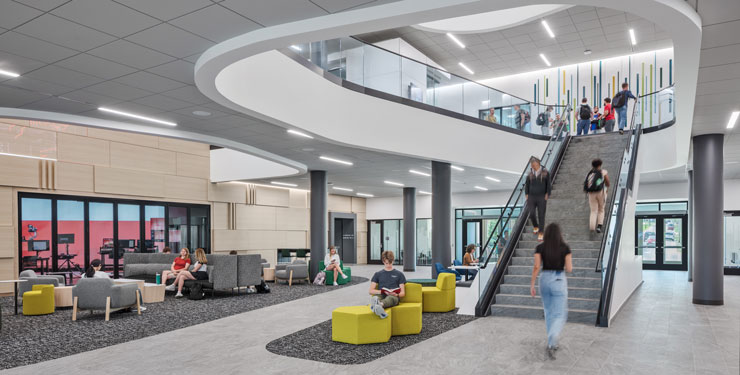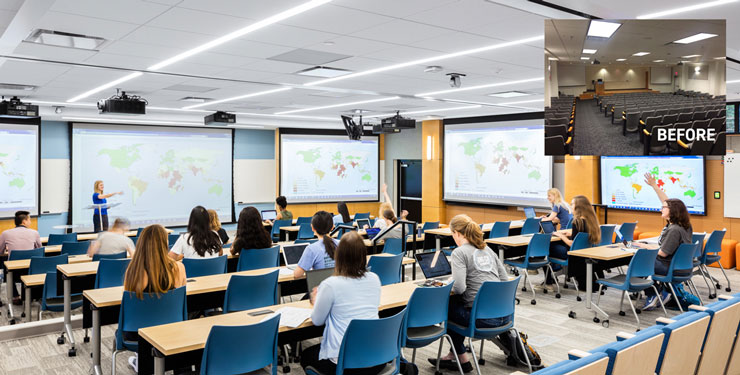
Designing for Wellness and Equity: Shaping the Future of Higher Education
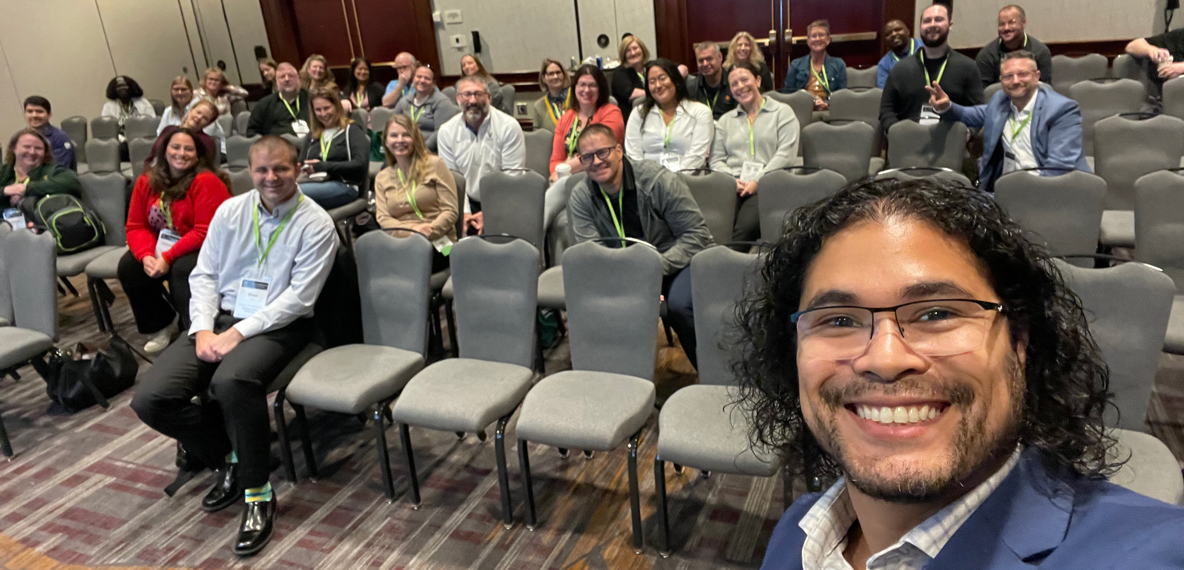
I recently attended the Central American College and University Business Officers (CACUBO) annual conference in Indianapolis, IN. The theme, Racing Towards Excellence, encapsulated the spirit of collaboration and innovation that permeated the event. This conference brought together colleagues and industry partners to exchange insights on the complexities of managing higher education institutions. It balanced practical knowledge with inspiring keynotes and forward-thinking ideas.
During the conference, I had the opportunity to present “The Coming Wave: Generation Alpha Student Life Needs” alongside Clair Knapp from Manchester University. Our presentation explored research on past generation trends and how societal changes influence the needs of Generation Alpha students. With only five years until they begin enrolling in higher education, it’s essential to start planning for their unique requirements. Understanding their future needs can assist Business Officers in financial planning for future capital projects. You can find more about our findings in BHDP’s white paper on Generation Alpha.
In this blog, I’ll reflect on some key takeaways from the conference, including the importance of creating spaces that promote well-being and collaboration while also addressing the distinct needs of future students.
Keynote Inspirations: Growth, Innovation, and Wellness in Higher Education
The keynote speakers provided valuable inspiration for business leaders, addressing themes that resonate across institutions.
- Zonya Foco discussed managing stress for resilience and well-being. Her energetic presentation encouraged attendees to incorporate movement into meetings, eat healthily, and use music to elevate their mental state. The focus here is clear: when campus administrators prioritize self-care, they can better serve students and institutions.
- Ben Whiting, a magician turned speaker, emphasized the importance of effective communication in enhancing group dynamics. Successful ideas do not rely on hope but on fostering relationships. He advocated for active listening and responding to team input rather than reacting. This emphasis on communication is critical in our design work, where collaborative spaces can facilitate open dialogue and connection among team members.
- Jeff Hayes spoke about unlocking potential through innovation, asserting that new ideas often emerge from small beginnings. By designing environments that encourage exploration and creativity, we can help our clients unlock the innovative potential of their teams.
- Justin Jones-Fosu encouraged attendees to shift their perspectives and reframe their experiences to achieve greater balance among tasks, relationships, and overall perspective. Integrating these insights into our design approach ensures that spaces not only meet functional needs but also foster a healthy work-life balance.
These speakers addressed key challenges our clients often face, such as the need for improved wellness, stronger communication, higher productivity, and increased innovation. We believe that environment shapes behavior. While renovations alone may not solve every issue, they can spark positive change. Our designers can create spaces that promote health and wellness through biophilic elements like natural light and greenery while also integrating features that encourage healthy habits. This could include expanding breakroom food prep and storage areas, offering healthier options, or using experiential graphic design to promote nutritional choices. Likewise, thoughtfully designed office spaces can enhance collaboration, turning standard conference rooms into dynamic hubs where ideas flourish. For more on the importance of holistic wellness in higher education, read my blog, “Beyond Academics: The Importance of Holistic Wellness and Personal Growth in Higher Education.”
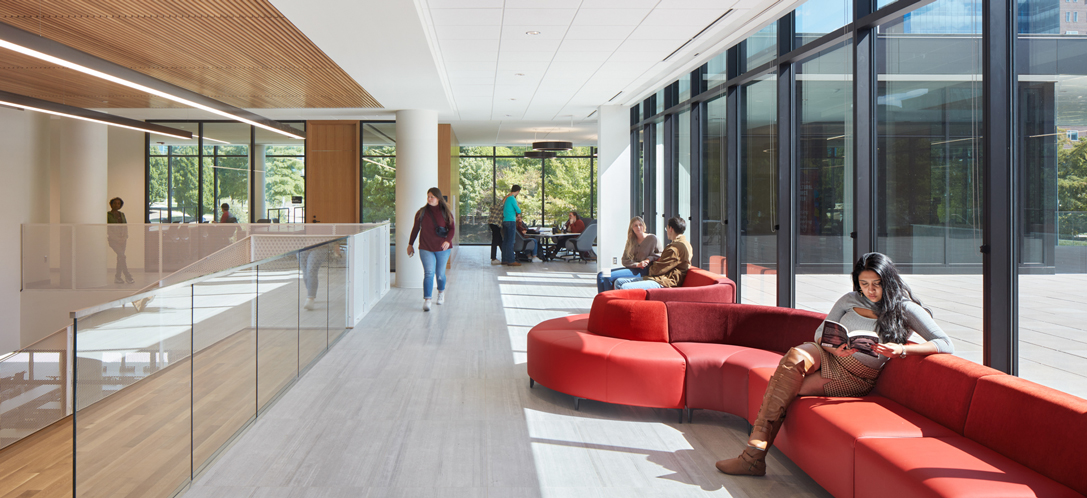
At the University of Cincinnati College of Law building, light-filled spaces invite collaboration among students, faculty, staff, and community. UC College of Law building project story
Creating Equitable Learning Environments Through Design
Throughout the conference, the theme of equitable access to education was a focal point, with several presentations addressing the steps institutions can take to advance student success. These discussions highlighted how thoughtful design can play a critical role in enhancing educational equity.
One notable presentation came from Ivy Tech, which showcased its workforce development program. This initiative uses stackable certificates and degrees to create a pathway for students, starting from those who may have dropped out of high school and culminating in a bachelor's degree. Ivy Tech collaborates with a broad ecosystem, including employers, childcare providers, community organizations, and state institutions, to ensure students receive comprehensive support throughout their educational journey.
As institutions explore these innovative programs, it's vital to consider how they can cater to the diverse needs of non-traditional students. The design of educational environments must adapt to support these varied student profiles. Designing flexible spaces that accommodate evening courses, late-night study sessions, and hybrid learning environments is essential. This may involve expanding instructional recording facilities, creating safe and welcoming campus environments for after-hours learning, and ensuring easy access to student services that cater specifically to non-traditional populations.
Another significant case study presented was by Follett Higher Education, the collegiate retailer, which illustrated a partnership with Purdue University Northwest focused on their new textbook access program. This initiative allows campuses to offer textbooks at a fixed rate, significantly reducing costs for students. More importantly, students have access to their textbooks on the first day of classes, which helps them feel more prepared and engaged from the outset. This proactive approach not only boosts retention and graduation rates but also levels the financial playing field across different majors, as the cost model is based on credit hours rather than individual course requirements.
Moreover, these textbook access initiatives can lead to a reduction in the square footage dedicated to traditional textbook sales. This valuable real estate on campus could be repurposed for other uses, such as expanding spirit wear, creating vibrant community spaces, or enhancing programs that foster student engagement.
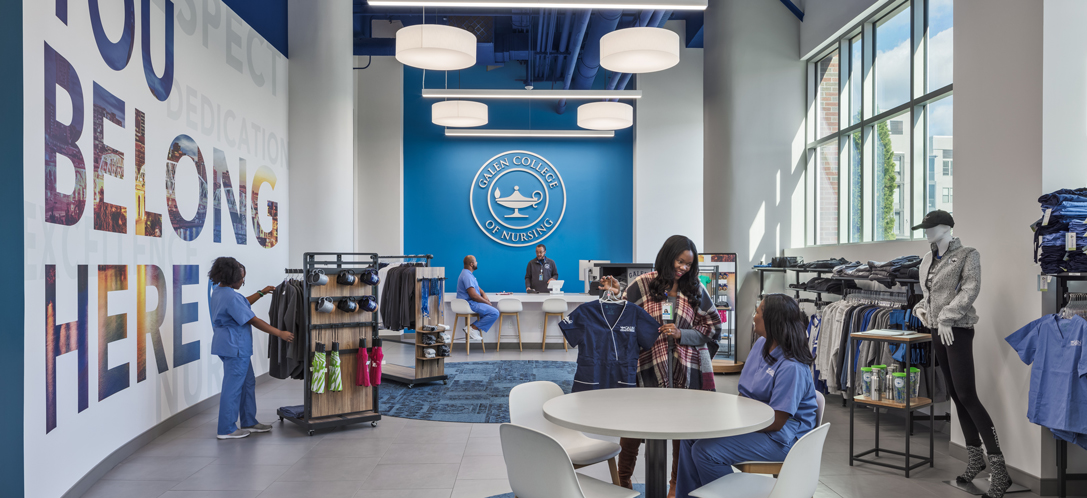
Galen College of Nursing's Nashville campus made the most of its street-front space by combining a spirit store with an enrollment center, using their brand to boost recruitment on a busy street.
As institutions move toward equitable access, it's crucial that they leverage design to create environments that not only support academic success but also cater to the holistic needs of their diverse student bodies. By prioritizing flexible, inclusive spaces, we can help pave the way for all students to thrive in their educational pursuits.
Paving the Way for Future Success
The outlook for higher education is promising, driven by a new generation of students and staff. As we navigate the transformative needs of our evolving world, administrators must focus on incremental changes that keep them relevant to students while ensuring faculty and staff satisfaction. At BHDP, we emphasize learning strategies in higher education, allowing us to consult with institutions and design spaces that reinforce their goals.
If you're interested in learning more about our Generation Alpha research or designing for wellness and equity, please fill out the form below.
Author
Content Type
Date
October 16, 2024
Market
Topic
Campus Planning


